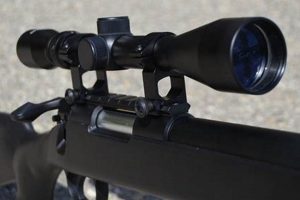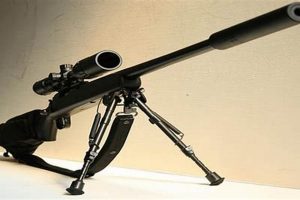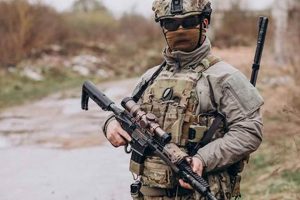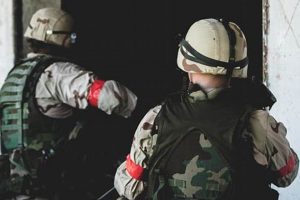Spherical projectiles, typically 6mm in diameter, utilized as ammunition in airsoft guns. These projectiles are commonly manufactured from plastic or biodegradable materials and are propelled by compressed gas or spring mechanisms. These are essential components for engaging in the airsoft sport.
The use of these projectiles allows participants to simulate realistic combat scenarios while minimizing the risk of serious injury. Their development has facilitated the growth and popularity of airsoft as a recreational activity and competitive sport. These projectiles have evolved from simple plastic pellets to include variations in weight, composition, and tracer capabilities, enhancing gameplay.
The following sections will delve into the different types available, factors to consider when selecting the appropriate type, safety considerations, and proper storage techniques to ensure optimal performance and longevity.
Guidance on Selecting and Utilizing Airsoft Projectiles
The following guidance offers practical advice to maximize performance, safety, and longevity when employing these essential components of airsoft weaponry.
Tip 1: Weight Selection. The weight directly impacts range and accuracy. Heavier types, such as 0.25g or 0.28g, generally offer improved stability in outdoor conditions. Lighter options, such as 0.20g, may be more suitable for indoor environments.
Tip 2: Material Composition. Biodegradable options minimize environmental impact and are often mandated by certain fields. Ensure compatibility with specific airsoft guns; some models may exhibit feeding issues with certain materials.
Tip 3: Surface Quality Inspection. Scrutinize each unit for imperfections or seams. Imperfections can lead to erratic flight paths and potential damage to the internal components of the airsoft gun.
Tip 4: Hop-Up Adjustment. Proper hop-up adjustment is crucial for achieving optimal range and accuracy. Experiment with different settings based on the weight used and the distance to the target.
Tip 5: Storage Protocols. Store in a cool, dry place, away from direct sunlight and extreme temperatures. Exposure to these conditions can degrade the material and negatively affect performance.
Tip 6: Gun Maintenance. Regular cleaning and maintenance of the airsoft gun are crucial for prolonging its lifespan and the projectiles’ performance. Check for jams and lubrication needs.
Tip 7: Safety Precautions. Always wear appropriate eye protection and adhere to field safety rules. Never aim the airsoft gun at individuals who are not participating in the activity.
Adhering to these tips contributes to enhanced performance, increased safety, and extended equipment longevity. Consider the factors discussed to choose the most suitable option and employ responsible practices.
With a clear understanding of selecting and employing these projectiles, the article will conclude with broader safety and environmental considerations for the sport of airsoft.
1. Weight
The weight of airsoft projectiles significantly influences their trajectory, range, and overall performance within the airsoft sport. Selecting the appropriate weight is crucial for achieving accuracy and consistency in gameplay.
- Trajectory and Range
Heavier projectiles generally exhibit greater stability and resistance to wind drift, leading to increased effective range. Lighter projectiles, while achieving higher initial velocities, tend to lose momentum more rapidly, resulting in shorter ranges and greater susceptibility to environmental factors. The ideal weight depends on field conditions and desired engagement distances.
- Hop-Up System Compatibility
The hop-up system imparts backspin to the projectile, counteracting the effects of gravity and extending its flight path. The effectiveness of the hop-up system is directly related to the projectile’s weight. Different weights require varying hop-up adjustments to achieve optimal performance. Failure to properly calibrate the hop-up system for a given weight results in either over-hopping (projectile rising excessively) or under-hopping (projectile dropping prematurely).
- Airsoft Gun Power and Performance
The power output of the airsoft gun also plays a crucial role in determining the optimal weight. High-powered guns, measured in feet per second (FPS), can effectively propel heavier projectiles, maximizing range and accuracy. Conversely, lower-powered guns may struggle to impart sufficient energy to heavier projectiles, resulting in reduced performance. Matching the projectile weight to the gun’s power output is essential for achieving balanced performance.
- Indoor vs. Outdoor Gameplay
Weight selection often depends on whether gameplay is occurring indoors or outdoors. Indoor environments, with minimal wind and shorter engagement distances, typically favor lighter projectiles for faster target acquisition and reduced risk of over-penetration. Outdoor environments, characterized by varying wind conditions and longer engagement distances, often necessitate heavier projectiles for improved stability and accuracy.
The interplay between weight, hop-up, airsoft gun power, and environmental conditions necessitates careful consideration when selecting appropriate airsoft projectiles. Experimentation with different weights and hop-up adjustments is essential for optimizing performance in various gameplay scenarios. Therefore, matching the projectile weight to the game environment is important to consider.
2. Material
The material composition of airsoft projectiles directly influences performance characteristics, environmental impact, and operational safety. The selection of material is a crucial decision, directly impacting projectile durability, trajectory consistency, and biodegradability. For example, standard plastic variants provide a cost-effective option but lack biodegradability, contributing to environmental pollution in outdoor environments. This contrasts with biodegradable projectiles made from polylactic acid (PLA) or similar materials, which offer a reduced environmental footprint.
The type of material used also affects the projectiles’ behavior within the airsoft gun’s internal mechanisms. Lower-quality, irregularly shaped projectiles, regardless of material, can induce jams, reduce accuracy, and potentially damage the gun’s internal components. High-precision projectiles made of polished, consistent materials minimize friction and ensure smooth feeding and firing. Tracer projectiles, often composed of a specialized luminescent polymer, exemplify the importance of material properties in achieving specific gameplay effects; these materials glow under UV light, enhancing visibility in low-light conditions.
Ultimately, the material chosen defines the practical constraints and advantages of airsoft projectiles. Selection criteria must balance factors such as cost, environmental responsibility, desired performance characteristics, and compatibility with the intended operating environment. The ongoing development of new materials continues to shape the capabilities and sustainability of airsoft weaponry, addressing challenges related to safety, accuracy, and environmental stewardship.
3. Diameter
The diameter of airsoft projectiles is a critical parameter influencing compatibility, accuracy, and safe operation within airsoft weaponry systems. Strict adherence to dimensional standards is crucial for reliable performance and minimizing the risk of equipment malfunction.
- Standardization and Compatibility
The industry standard diameter for airsoft projectiles is 6mm. Variations outside of this specification, even by fractions of a millimeter, can lead to feeding problems, reduced accuracy, and potential damage to the airsoft gun’s internal components. Consistent diameter ensures proper alignment and smooth passage through the barrel, maximizing energy transfer and shot consistency.
- Accuracy and Ballistic Performance
Dimensional uniformity directly impacts ballistic performance. Irregularities in diameter can cause inconsistent spin during flight, leading to deviations from the intended trajectory. Precision-manufactured projectiles with tight diameter tolerances offer improved accuracy and predictability, enhancing the overall gameplay experience.
- Hop-Up System Interaction
The hop-up system relies on consistent projectile diameter to impart the correct amount of backspin. Variations in diameter can disrupt this interaction, resulting in either over-hopping (the projectile rising excessively) or under-hopping (the projectile dropping prematurely). Proper hop-up function is essential for achieving optimal range and accuracy.
- Safety Considerations
Using projectiles with diameters significantly deviating from the 6mm standard can pose safety risks. Oversized projectiles may become lodged in the barrel, potentially leading to malfunctions or damage to the airsoft gun. Undersized projectiles may not properly engage the hop-up system, resulting in erratic flight paths and reduced control over where the projectile lands.
The 6mm diameter standard is a cornerstone of airsoft projectile design, ensuring compatibility, accuracy, and safe operation across a wide range of airsoft guns. Deviation from this standard can compromise performance, increase the risk of equipment damage, and potentially lead to safety hazards. Therefore, using a consistent, regulation diameter is critical.
4. Accuracy
Accuracy in airsoft is intrinsically linked to the quality and consistency of projectiles. Variations in weight, shape, and surface imperfections among projectiles induce deviations in flight trajectory. These deviations compromise accuracy, affecting the user’s ability to consistently hit intended targets. For example, projectiles with uneven surfaces experience inconsistent air resistance, leading to erratic movement and reduced precision. The more uniform the batch of projectiles, the better the accuracy of each firing, which directly influences competitive outcomes and training effectiveness.
The hop-up system, a mechanism within airsoft guns designed to impart backspin to projectiles, is heavily reliant on consistent projectile characteristics for optimized accuracy. Inconsistent projectile diameters disrupt the intended interaction with the hop-up, resulting in variations in spin rate and unpredictable trajectory. Moreover, the projectile’s weight must correspond to the hop-up setting. If the weight is wrong, this has a huge effect on the accuracy.
Overall, achieving high levels of accuracy in airsoft necessitates stringent quality control in projectile manufacturing. Users must ensure that they are using projectiles that adhere to tight tolerances regarding weight, shape, and surface finish. This investment in quality translates to improved performance and a more realistic simulation experience. Accuracy is a complex relationship within the ecosystem of airsoft.
5. Velocity
The velocity of airsoft projectiles is a critical factor determining their impact force, range, and overall effectiveness in gameplay. Expressed in feet per second (FPS) or meters per second (m/s), velocity directly correlates to the kinetic energy imparted upon impact. Higher velocities generally result in greater range and a more pronounced sensation upon striking a target. However, increased velocity also elevates the potential for injury, necessitating adherence to established safety regulations and field limits.
Airsoft fields commonly enforce velocity limits to mitigate the risk of injury. These limits vary depending on the type of airsoft gun and the role it occupies within gameplay. For example, sniper rifles, designed for long-range engagements, may be permitted to operate at slightly higher velocities than assault rifles or pistols, albeit with stricter minimum engagement distances. The use of chronographs to measure the velocity of airsoft guns is a standard practice to ensure compliance with these safety regulations. Projectile weight influences velocity; lighter projectiles typically achieve higher velocities with the same airsoft gun, necessitating careful consideration to remain within established limits.
Understanding the relationship between projectile velocity, weight, and the potential for injury is paramount for responsible airsoft participation. Compliance with established velocity limits is essential for ensuring player safety and maintaining the integrity of the sport. The proper balance of velocity is key for effective gameplay in the sport of Airsoft.
6. Biodegradability
Biodegradability represents a critical consideration in the context of airsoft projectiles. The proliferation of non-biodegradable plastic projectiles results in environmental accumulation, posing a threat to ecosystems. The shift towards biodegradable materials addresses this concern by facilitating natural decomposition, minimizing long-term environmental impact. The composition of these biodegradable projectiles typically includes polymers that can be broken down by microorganisms, contributing to a more sustainable practice.
The adoption of biodegradable airsoft projectiles is increasingly mandated by airsoft fields and organizations to mitigate environmental contamination. For example, several organized airsoft events now require the exclusive use of biodegradable options. This transition necessitates that manufacturers develop projectiles that meet performance standards while adhering to biodegradability criteria. Practical applications include the reduced accumulation of plastic waste in natural environments and the promotion of environmentally conscious behavior among airsoft participants. These projects can reduce the burden on our natural environment.
Challenges remain in ensuring consistent biodegradability across diverse environmental conditions and maintaining projectile performance comparable to traditional plastic options. However, the integration of biodegradable projectiles into airsoft reflects a growing awareness of environmental responsibility and a commitment to sustainable practices. Future developments will likely focus on enhancing the biodegradability rates and expanding the availability of high-performance biodegradable options. As environmental concerns continue to mount, transitioning the sport into an ecosystem friendly environment.
Frequently Asked Questions about Airsoft Projectiles
The following addresses common inquiries regarding the characteristics, usage, and safety considerations of airsoft projectiles. This information aims to provide a comprehensive understanding for informed decision-making.
Question 1: What is the standard size of airsoft projectiles?
The industry standard diameter is 6mm. Deviation from this measurement can lead to performance issues and potential damage to airsoft guns.
Question 2: What materials are airsoft projectiles typically made from?
Common materials include plastic, biodegradable polymers (e.g., PLA), and specialized materials for tracer projectiles. Each material possesses distinct performance and environmental characteristics.
Question 3: How does the weight of an airsoft projectile affect its performance?
Weight influences range, accuracy, and stability. Heavier projectiles generally offer improved stability in outdoor conditions, while lighter projectiles may be more suitable for indoor environments.
Question 4: Are all airsoft projectiles biodegradable?
No, not all are biodegradable. Biodegradable options are available and increasingly mandated by airsoft fields to mitigate environmental impact. Plastic variants remain prevalent but lack biodegradability.
Question 5: What safety precautions should be observed when using airsoft projectiles?
Appropriate eye protection is mandatory. Adherence to field safety rules is essential. Never aim airsoft guns at individuals who are not participating in the activity.
Question 6: How should airsoft projectiles be stored?
Storage in a cool, dry place, away from direct sunlight and extreme temperatures, is recommended. Improper storage can degrade the material and negatively affect performance.
Understanding these aspects of airsoft projectiles helps ensure safe, effective, and environmentally conscious participation in the sport. Selection of proper projectiles also increases the lifespan of the gun.
The next section will provide information on different types of airsoft guns.
Conclusion
This article has provided a comprehensive overview of “bolinhas airsoft,” encompassing their composition, selection criteria, performance characteristics, and safety implications. The importance of factors such as weight, material, diameter, and velocity has been discussed in detail, along with the significance of biodegradability for environmental responsibility. Furthermore, the frequently asked questions addressed common concerns, reinforcing the understanding necessary for informed usage.
Responsible participation in airsoft necessitates a thorough comprehension of these projectiles and their impact. Continued adherence to safety protocols and environmentally conscious practices remains crucial for the long-term sustainability and integrity of the sport. As the field of airsoft evolves, staying informed about advancements in projectile technology and regulations will ensure both optimal performance and responsible engagement. Continued innovation and safety consciousness will ensure a more positive experience.







